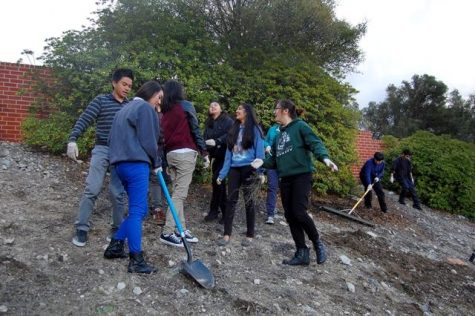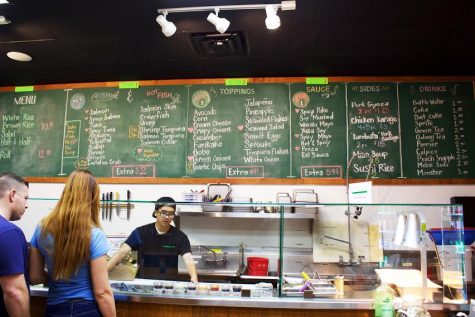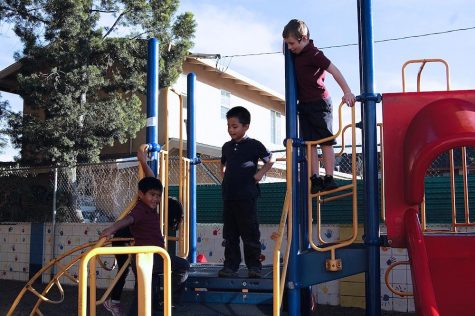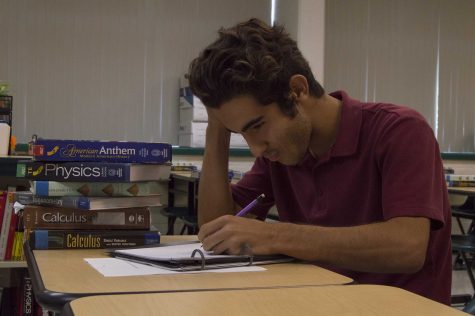Plastic and marijuana research win Lexus Eco-challenge
 (January 31, 2013) — “Everybody says that marijuana is just an herb, so it’s not going to hurt them,” said senior Meleeneh Hairapetian. “Our project sets out to prove that that isn’t true. If it doesn’t hurt you, it hurts your environment, really badly.”
(January 31, 2013) — “Everybody says that marijuana is just an herb, so it’s not going to hurt them,” said senior Meleeneh Hairapetian. “Our project sets out to prove that that isn’t true. If it doesn’t hurt you, it hurts your environment, really badly.”
The Econarks of teacher Dominique Evans-Bye’s period 1 Environmental GIS class recently won $10,000 from the Land-water competition of the Lexus Eco-Challenge. Their project was to document the contaminants found in illegally-grown marijuana and the damage growing marijuana does to the environment.
“They rip out native plants and plant marijuana, and then they harvest it and leave the hillside bare,” Evans-Bye said. “When it rains, you have major soil erosion.” As part of their research, the Econarks went to growth sites and observed the environmental damage of growing illegal marijuana.
“We saw this growth site in Ojai, and it was just littered like crazy,” Hairapetian said. “They set up camp in the middle of nowhere, and they had poured fertilizer all over the place because they want these plants to grow as fast as they can.” The Econarks also discovered that animals that pass through end up eating the pesticides and dying. “It’s bad in pictures, but up close, it’s even worse,” Hairapetian said. According to Evans-Bye, the rain washes the fertilizer to the watershed, and that creates algal blooms, and decreases oxygen levels in streams. All the toxic and deoxygenated water goes to the ocean.
Massive amounts of pesticides are used, including rat poison. “They don’t clean the plants off before the marijuana is available on the street to people,” Evans-Bye said. “Most people don’t think about it when they’re smoking marijuana, but they’re smoking pesticides like DDT (dichlorodiphenyltrichloroethane) and rat poison.” The Econarks have presented their research to various organizations. “We talked to the Ventura County Police Department about our project, and they were blown away.
They’ve come to everything we’ve presented at,” Hairapetian said. “We presented at GIS day and everybody showed up, from the entire narcotics department, and they were so proud of us and excited.” The period 2 Riptides also won $10,000 from the Air-climate section of the Lexus Eco-Challenge on Jan. 15. The Riptides found a possible solution to the problems of global warming and sustainable energy, in plastic. “The Riptides did some research, and found a type of plastic, an experimental plastic, called PEI (polyethyleneimine), and this plastic sequesters carbon, it absorbs it,” Evans-Bye said.
“We were using PEI to create our prototype CO2 filter to fit into the exhaust pipe of cars, specifically Lexus,” said senior Zane Toyon. “That was the basis of our project, the execution was much more difficult,” he said. According to junior Adriel Dela Paz, PEI is liquid at room temperature and is highly toxic. It could grab carbon dioxide from the air once it is mixed with the right substance so it stays solid.
“We first started out working on the prototype for the car filter, and after that, we found more applications for it, like the windmill, Dela Paz said. “Then somewhere in the middle, the idea of a native plant garden came out.” The Riptides project involved their research of PEI and their application of it through a native plant garden on the hillside behind Clark. They pulled the weeds, built a small trail, and designed a plant garden.
The Riptides designed windmills for their native plant garden in the computer-aided design (CAD) lab at Clark. “We’re going to get the windmills and we’re going to dip those in the plastic, so as they’re outside, they’re collecting CO2 as well,” said senior Joni Kang. The Riptides also received gnomes from teacher Kelly Brinker, and used a laser etcher to write tips on how to reduce your carbon footprint on them. The gnomes will be hidden throughout the native plant garden.
The Riptides’ final challenge is to prototype the filter and to apply it in cars. “We didn’t physically prototype it, we managed to create it in CAD, but we weren’t able to prototype it in time for the air climate challenge,” Toyon said. “Now we have to actually make the filter work,” Kang said. “Because not only did we have to show that the plastic worked, but now it does work, so now we have to make the actual prototype.”
Toyon hopes to have their prototype patented, and says that with their filter, cars could potentially get power from their own exhaust. “You can literally wash off the plastic so that the CO2 comes off and then can be re-done so that it turns into a type of fuel,” Toyon said.
According to Toyon, the solution that is washed off has an ethanol fuel base. “You could theoretically fuel your car, with exhaust that comes out of your car, so you get every last bit of energy out of it,” he said. According to Evans-Bye, the final challenge is a more global application of the local environmental issue the students have chosen. “Both these teams have shown amazing dedication and enthusiasm for this project,” she said. “I have every confidence that they’re going to come out with an amazing final challenge project.”







